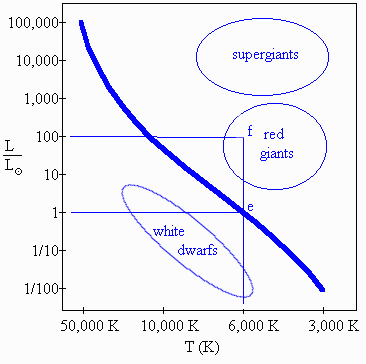
PHYSICS 1040 - ELEMENTARY ASTRONOMY - HOMEWORK #10
1. The relation between the parallax angle p (in arcseconds) and the distance d (in parsecs) to a star is

a. The distance to a star with p = 0.25 arcseconds is
d = 1/(0.25) = 4 parsecs.
b. The distance to a star with p = 0.005 arcseconds is
d = 1/(0.005) = 200 parsecs.
2. If a star has apparent magnitude m and absolute magnitude M, then the distance d (in parsecs) to the star is
d(parsecs) = 10[m - M + 5]/5
a. If m = 13.6 and M = 8.6, then
[m - M + 5]/5 = [(13.6) - (8.6) + 5]/5 = [10]/5 = 2,
and so d
= 10[m - M + 5]/5 = 100 parsecs.b. If m = 7.2 and M = -2.8, then
[m - M + 5]/5 = [(7.2) - (-2.8) + 5]/5 = [15]/5 = 3,
and so d
= 10[m - M + 5]/5 = 1000 parsecs.c. If m = 9.1 and M = 9.1, then
[m - M + 5]/5 = [(9.1) - (9.1) + 5]/5 = [5]/5 = 1,
and so d
= 10[m - M + 5]/5 = 10 parsecs.(By definition, m = M when d = 10 parsecs!)

3. On the Hertzsprung-Russell diagram shown at right, identify
(a) the main sequence;
(b) the region of giant stars;
(c) the region of supergiant stars;
(d) the region of white dwarf stars;
(e) the position of the Sun; and
(f) the position of a star with 100 times Sun's luminosity, but with the same temperature as the Sun.
4. An O star, a G star, and an M star are on the main sequence of the Hertzsprung-Russell diagram.
Which star is hottest? O
Which star is coolest? M
Which star has the largest luminosity? O
Which star has the smallest luminosity? M
Which star is most massive? O
Which star is least massive? M
Which star is most like the Sun? G
5. The total energy per second emitted by a star is called the star's luminosity. The luminosity of a star depends both on the star's temperature and the star's surface area. The ratio of the luminosities LA and LB of two stars A and B is related to their radii (RA and RB) and their surface temperatures (TA and TB) by

This means that if star A is 5 times larger than star B, and if star A has twice the surface temperature of star B, then
LA/LB= (5)2 (2)4 = 400.
Thus a star with 5 times the Sunís radius and twice the Sunís surface temperature has 400 times the Sunís luminosity.
6. Kepler's 3rd law, as derived by Newton, says that a3/P2 = M1 + M2, where a is the semimajor axis of the orbit of the two stars (in AU), P is the period of the orbit (in years), and M1 and M2 are the masses of the two stars (in solar masses). Suppose the semimajor axis of a binary star system is a = 4 AU and the period is 2 years. Then the sum of the masses of the two stars is M1 + M2 = a3/P2 = (4)3/(2)2 = 16 solar masses. Also suppose, from observing the orbits of the two stars about their barycenter (center of mass), we know that star 1 is three times more massive than star 2; that is M1 = 3M2. Then we can conclude that M1 = 12 solar masses and M2 = 4 solar masses.
7. A binary star system (an orbiting pair of stars) may be too far away to be seen as two separate points of light. However, the spectrum of the binary star system may be used to detect the presence of two stars. The spectral lines of the star moving toward Earth will have a blue shift, and the spectral lines of the star moving away from Earth will have a red shift. This pattern of Doppler-shifted spectral lines moves back and forth during every orbital period. Such a system is called a spectroscopic binary system. If the two stars eclipse (move across) each other, the mass and the radius of each star can be determined.
8. An emission nebula (also called an HII region) is a huge cloud of hydrogen gas that glows a characteristic pinkish red. These nebulae are powered by the ultraviolet light emitted by nearby, very hot stars, and are frequently seen surrounding sites of active star formation. A reflection nebula is produced when starlight is reflected from a huge cloud of dust; it has a characteristic blue color.
9. Stars are formed in dark nebulae, cold (10 K), dense interstellar clouds of gas and dust that light cannot penetrate. A protostar is the hot core of a collapsing dark nebula. Nuclear fusion reactions have not yet started at its center, so it is not yet a star. Its light and heat come from the conversion of gravitational/thermal energy (circle one) into gravitational/thermal energy (circle one). When the center finally becomes hot and dense enough, nuclear fusion reactions begin, producing the light and heat of the newly born main-sequence star. Dark nebulae are found in the giant molecular clouds that populate the spiral arms of our Milky Way galaxy.
10. When nuclear fusion reactions are about to begin in the center of a protostar, the protostar may eject huge amounts of gas into space. Low-mass stars that vigorously eject gas are called T Tauri stars. Our Sun went through a T Tauri phase as it became a main-sequence star. If the protostar is surrounded by a disk of gas and dust called an accretion disk, the ejected gas may be focused into two fierce jets of gas that are directed perpendicular to the accretion disk.